|

by Wal Thornhill
from
Holoscience Website
18 August 2003
The grandest canyon in
the solar system is Valles Marineris on Mars. It stretches a third
of the way around the planet. But what in heaven can spiral
galaxies have to do with the geology of Mars’
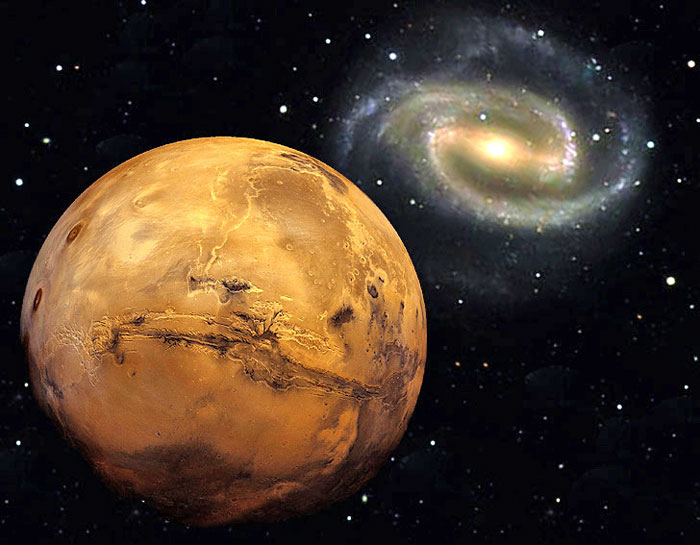
The great scar of
Valles Marineris looks as if it has been burnt into the planet’s
face.
Behind, a barred
spiral galaxy glows from the depths of space.
It is so called
because the spiral arms begin from the ends of a bar rather than the
center of the galaxy.
About 1/3rd of all
spirals are barred, including our Milky Way galaxy.
In October 2001, I wrote,
"In light of more
than a century’s research in the field of plasma cosmology and
the 20th century discoveries of the space age, we can
confidently propose the celestial thunderbolt as a common cause
of the formation of canyons and rilles on rocky planets and
moons.’"
At that time I had not
come to any conclusion about the details of the electrical event
that created the colossal Valles Marineris canyons on Mars. Like
geologists, I use a process of pattern matching when attempting to
understand the processes that may have formed a feature seen on the
surfaces of planets and moons. But unlike geologists, who have been
seriously misled by astrophysicists and are now confused by what
they see on Mars, I have the luxury of contemplating the effects of
the most powerful erosion force in the universe: that of the
electric arc.
Following the lead provided by Ralph Juergens in the 1970’s I looked
at the detailed morphology of Valles Marineris to conclude that it
was a scar caused by a cosmic discharge. But the question remained:
how did the arc move to create a chasm at least 4000 kilometers
long’ There is no obvious start or finish to the canyons. Indeed
there is a kind of symmetry about the central region of Melas Chasma.
Electrical effects offer a unique advantage in being scalable over
more than 14 orders of magnitude. In other words, erosion effects
observed under an electron microscope provide direct insights into
planetary features on a scale of hundreds or thousands of kilometers.
However, I had limited my perspective by not looking at large scale
galactic objects to see if there were any clues in their patterns to
the much smaller features on planetary surfaces. The connection lies
in the fact that galaxies are the largest visible electric discharge
phenomenon in the universe.
That may be a controversial statement when conventional astrophysics
uses the weakest force in the universe, gravity, in a
fruitless
attempt to explain the dynamics of galaxies. It is a glaring
indictment of the way science works when a compelling competing
theory is neither mentioned nor tested against an accepted theory
that requires ad hoc and mysterious ’dark matter’ and ’dark energy’
in order to appear to work. It has forced plasma physicists and the
IEEE to hold separate meetings and to publish
papers on plasma cosmology. With a
very few notable exceptions, the astronomical community ignores the
subject.
The strongest support for plasma cosmology comes from the close
correspondence between observations, supercomputer simulations and
experiment. It does not require any new forces, new physics or
phantom particles to force a match with observations. It explains
why galaxies naturally favor the beautiful spiral form. Gravity
alone can only produce featureless disks. The current theory of
planet formation relies on this fact.
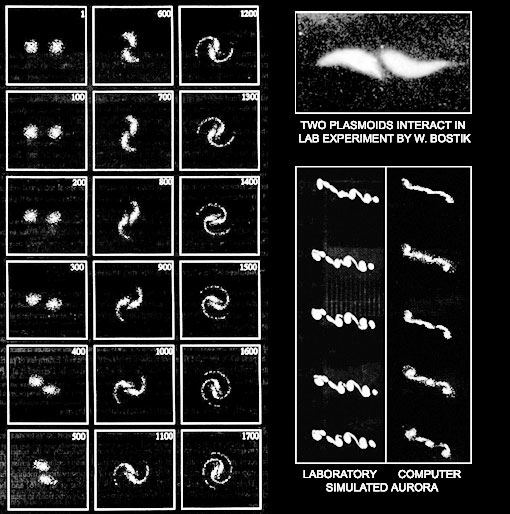
On the left is
a series of single frame stills from a computer animation of a
cross-section through two interacting Birkeland current filaments.
Not shown is the
elliptical core of plasma trapped at the geometric center of the
simulation.
Top right is
the form taken by two interacting plasmoids fired at each other
across a magnetic field (courtesy of W. Bostik).
Below that,
side by side to show the striking correspondence between lab
experiment and computer simulation in plasma cosmology,
are the development
of auroral instabilities as current increases from top to bottom.
.
All images are from
Physics of the Plasma Universe by
Anthony Peratt.
In the simulation of the electrical formation of a spiral galaxy the
two fuzzy spots in the earlier frames show where two cosmic current
filaments pass vertically through the plane of the developing
galaxy. The force between these cosmic current filaments is more
powerful and long-range than gravity, declining linearly with
distance. It leads to a natural pairing of filaments when many
filaments are present in plasmas in which the magnetic field plays a
major role.
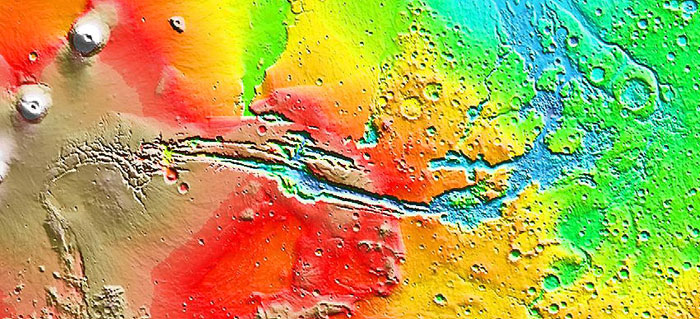
I accounted for the
pairing and rotation of plasma current filaments when explaining the
formation of circular craters. However, it was not until I examined
the MOLA topographic map of Mars
(above) that I realized the
extended form of Valles Marineris and connected canyons was
identical to that of a classic barred-spiral galaxy.
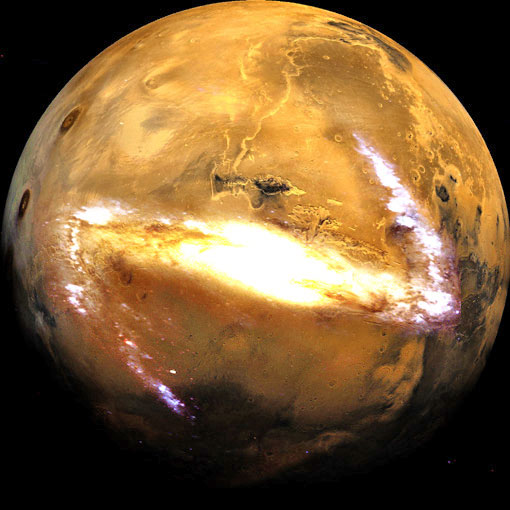
It seems that a
cosmic thunderbolt has struck Mars with two huge filaments or
plasmoids focussed
on a spot now
occupied by the deepest central canyons of Valles Marineris.
Electromagnetic
forces then constrained the discharge across the surface of Mars to
the classic shape of a barred spiral.
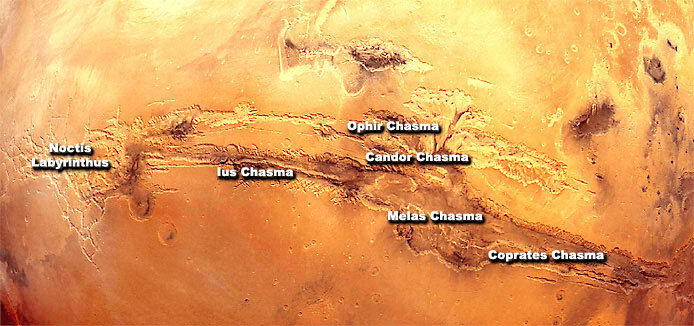
All of the enigmatic
large-scale features of Valles Marineris then have a coherent and
simple explanation. Note the tendency for Ius Chasma to be concave
downwards and Coprates Chasma to be concave upward. That matches the
effect seen in Bostik’s lab experiment above. Also many odd details
make sense. For example, for the aficionados of powerful plasma
discharges, the ’bar’ is formed by Ius Chasma to the west and
Coprates Chasma to the east. At their extremities they "pinch" down
before entering large chaotic regions, Noctis Labyrinthus in the
west and Capri Chasma and Eos Chasma in the east. This is typical of
diocotron instabilities that sometimes occur in the arms of spiral
galaxies. After pinching down, the discharge curves and balloons
out. The surface damage is spread over a greater area, forming
chaotic etched terrain in the east and a vast system of pitted
trenches in the west. The act of pinching the discharge leads to
filamentation, which may be seen in the thin parallel channels at
the extremities of the main canyons. The filamentation instability
occurs most readily at large currents. This effect could also
explain the tendency to "doubling" of the canyons, to form a central
ridge.
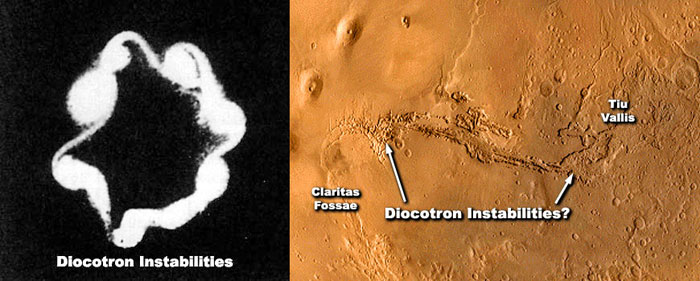
Electrons rushed from
remote regions along the outer ’spiral arms’ of Claritas Fossae in
the west and a number of channels including Tiu Vallis in the east.
In doing so they created the usual electrically scoured channels. As
Michael Carr, leader of the Viking Orbiter imaging team noted,
’Canyons, chaos and outflow channels are thus physically connected,
and their origins may be in some way related.’
There are some smaller parallel canyon systems, closed at both ends,
to the north of Valles Marineris. They appear to be the result of
smaller discharges of the same type as created Valles Marineris,
probably immediately following the main stroke. Multiple strokes,
decreasing in intensity, are a well-known characteristic of
lightning.
The Accepted
Model
No one was there to witness the evolution of the Earth, so
geologists have constructed an elaborate story about the history of
the Earth. It is founded upon a simple belief that the planets were
all formed at about the same time and have remained for billions of
years in their present orbits. It was inevitable that chapters of
the Earth’s story would be translated to Mars. The result is a
succession of hypothetical Martian ’ages’ including a ’Noachian’ age
of deluge. And remember that this is a story about a frozen desert
planet!
One of the most highly developed capabilities of the human mind is
to concoct stories. Equally, we have a strong desire to be told
stories and to believe them. If we believe a story to be true we
have a strong tendency to accept confirming evidence and to ignore
contrary evidence. Geologists are human and show the same tendencies
when explaining planetary surface features.
The idea of former oceans and rivers existing on Mars came from the
many scoured channels and the flat, low terrain in the northern
hemisphere. This marked hemispheric dichotomy is inexplicable by any
known geological or astronomical effect. It has never occurred to
geologists that the agent involved was electrified plasma. Why
should it’ Astrophysicists tell them that we live in an electrically
neutral universe in which cosmic charge separation is impossible.
But if that single assumption is incorrect everything changes. If
the visible universe suffers cosmic charge separation then we have a
source of energy to build and shape galaxies, light stars, give
birth to planets, organize stable orbits and leave the resulting
scars of electrical transactions on all solid bodies.
Implications
of the Plasma Model
Gigantic fresh scars show that Mars has suffered recently and
terribly. Millions of cubic kilometers of jagged boulders were burnt
and torn from its surface and strewn from horizon to horizon, as
all of the images relayed from the surface have shown. The
implications for the search for life on Mars are profound. If there
was a past environment conducive to life on Mars it has been
wrecked. Not only the surface suffered but also the atmosphere was
stripped and exogenous gases and solids dumped on the hapless
planet. Mars’ orbit and climate changed drastically.
|
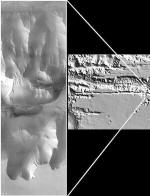
See the
THEMIS website for the fullsize
image of the eastern end of Ius Chasma |
It is interesting to compare a geological story of Mars with that of
the electrical.
The image on right has the following explanation
attached:
"The steep canyon
walls and ridge forming layers of Valles Marineris are on
display in this THEMIS picture. Landslides and gullies observed
throughout the image are evidence to [sic] the continued mass
wasting of the martian surface. Upon close examination of the
canyon floor, small ripples that are likely migrating sand dunes
are seen on the surface. Some slopes also display an interesting
raked-like appearance that may be due to a combination of
aeolian and gully forming processes."
The term "mass wasting"
for Valles Marineris is a euphemism for the disappearance of
millions of cubic kilometers of rock and soil. The two mechanisms
proposed for the formation of Valles Marineris are underground water
erosion or massive surface rifting. Neither stand up to scrutiny.
There is no mechanism available to geologists to cause mass wasting,
particularly on such a gargantuan scale. The minor features are
merely explained in an ad hoc fashion.
The electrical model now has a coherent explanation for the broadest
features of five major and distinct landforms associated with Valles
Marineris. The five features are:
1.
the Valles Marineris canyons
2. Noctis Labyrinthus
3. Claritas Fossae
4. the eastern chaos region
5. the great eastern valley systems
The missing mass (shades
of the purely gravitational thinking of astronomers) was not
transported or buried on Mars. It was lofted toward space by blast
and electrical forces. The same kind of process operates far more
quietly today on Io, lofting matter hundreds of
kilometers into
space. The fact that we receive martian meteorites today is solid
evidence of the removal of rocks from the surface of Mars in the
recent past.
The electrical model also explains the detailed features. The small
ripples on the canyon floor are not sand dunes but a solid reminder
of the path of the arc that blasted the canyon. They are massive
"fulgurites" - the glassified sand formed by underground lightning.
They are transverse to the arc because they record the corona
discharge filaments associated with lightning. The same effect seems
to have solidified the soil along the ridge crests into "Lichtenberg
figures," which is another characteristic pattern created by
lightning. Ridge crests and canyon edges would be the focus of
secondary discharges. The raked appearance of the slopes are
probably the result of surface lightning feeding the ridge crests
with electrons to satisfy the discharges there. We find such
patterns of grooves on objects as diverse as asteroids, moons and
planets.
For reasons yet to be revealed, I think it likely that Mars in the
recent past had an environment not much different to that of the
Earth. But the extensive layering on Mars suggests the earlier
environment was globally and episodically buried and electrically
scarred when that changed . That could explain the detection of
extensive subsurface ice, if the hydrogen signature found by the
Odyssey spacecraft is due to water. Certainly, Martian craters with
flow features away from their rims fit such a picture. The flows are
due to electric heating of ices by subsurface currents flowing away
from the arc that formed the crater.
What about the Grand Canyon. As many geologists have pointed out,
the Grand Canyon is the size of a mere tributary of Valles Marineris.
The Grand Canyon shows detailed similarities to the canyons of Valles Marineris but the discharge that created it did not take the
same striking shape.
If forced to use a galactic analogy, it could
be the equivalent of a dwarf irregular galaxy.
|







